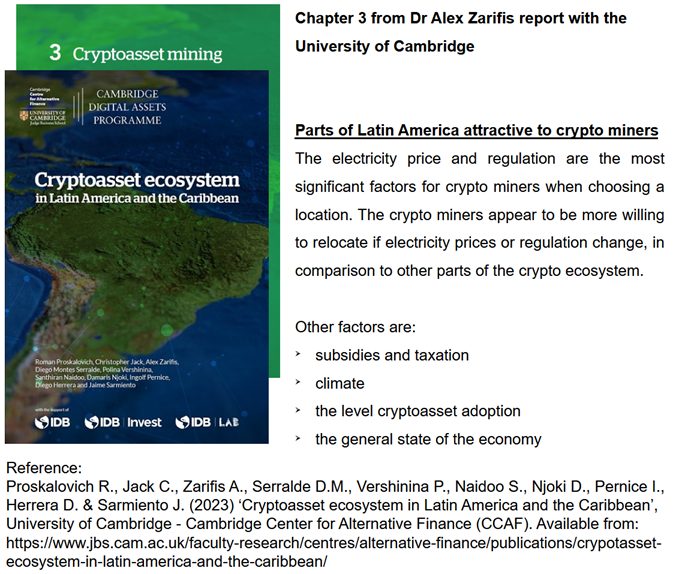Dr Alex Zarifis
I am going to talk to you about the business models, and ecosystems, of cryptomining in Latin America. This is the third chapter in my report with the University of Cambridge, Judge Business School (Proskalovich et al. 2023). I have given a general overview of this report already, so I am just focusing on the chapter on cryptomining here.
The blockchain consensus mechanism used in Bitcoin, and some other cryptocurrencies, requires mining for the proof-of-work process. Mining, helps verify transactions and create new cryptoasset tokens. Activity from companies and individuals in this area can positively impact the cryptoasset ecosystem, by encouraging cryptoasset adoption, and providing an income stream.

Figure 1: The factors making Latin America popular for crypto mining
Cryptomining in Latin America happens in registered mining companies, mining pools, and so called ‘ant farms’. Mining pools are a form of cooperation in which people share the risks and returns from mining. ‘Ant farms’ are created by hobbyist that install mining equipment in a residential area.
Latin America has some characteristics that support cryptomining and allow miners to be competitive internationally. These features include relatively cheap electricity and renewable power resources, such as solar, hydro and geothermal. The electricity price is one of the most significant factors determining the profitability of cryptomining, and whether a country will become a cryptomining hub. Despite this, Bitcoin mining in this part of the world is still only a small part of the global mining volume.
The popularity of cryptomining varies across Latin American countries. Some of the leading bitcoin mining countries in this part of the world are Brazil, Paraguay, Venezuela, Mexico and Argentina. In addition to electricity prices, other determining factors are regulation, subsidies, climate, the level cryptoasset adoption, and the general state of the economy. Mining is not widespread in the countries of this region where cryptocurrencies are partially, or entirely, banned.
The crypto mining industry seems to be very sensitive to regulation and electricity prices, and does not appear to be as ‘sticky’ to a geographic location as other parts of the crypto ecosystem. Some miners even have their IT hardware permanently in shipping containers when they are operating, so they can transport it to another country relatively easily. Changes in how countries regulate crypto mining often have a knock-on effect. For example, when Venezuela made regulation stricter, some mining activity moved from there, to Brazil.
If you want to learn more about this part of the cryptoasset ecosystem, you can read the third chapter of the report.
Reference
Proskalovich R., Jack C., Zarifis A., Serralde D.M., Vershinina P., Naidoo S., Njoki D., Pernice I., Herrera D. & Sarmiento J. (2023) ‘Cryptoasset ecosystem in Latin America and the Caribbean’, University of Cambridge – Cambridge Center for Alternative Finance (CCAF). Available from: https://www.jbs.cam.ac.uk/faculty-research/centres/alternative-finance/publications/crypotasset-ecosystem-in-latin-america-and-the-caribbean/